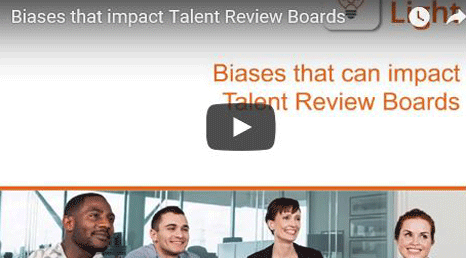Talent Review Boards are one of the most significant meetings in an organisation’s succession planning – and yet its decisions can be subject to bias.
By becoming more aware of bias and by putting strategies in place to minimise or reduce their effects during talent reviews – or indeed any aspect of people management – we can improve the quality of the decisions we make.
Of course, we can’t remove the influence of bias completely – in fact, we are biased towards not consciously picking up on them!
So, involving third parties or trained facilitators in the quality checking and reviewing of decisions is invaluable. The individuals who are going to mediate the process should be:
- well-versed in personnel assessment,
- have the presence and credibility to be able to challenge senior managers and
- be aware of the pitfalls in individual and group decision-making; so when they spot them, they can surface them and address them.
Our article - Making Talent Reviews more effective - highlights some of the most common biases and below we offer a 10-point checklist on how to counteract these and thereby reduce bias overall.

Before the review meeting, check yourself for …
- Self-interested bias – and ask yourself, ‘How might self-interest be motivating me?’
- The Heuristic effect - Am I minimizing individual weaknesses and exaggerating their strengths? Or vice versa?
- The WYSIATI assumption – This is the ‘What you see is all there is’ assumption. Fast forward and ask what additional information would I want? Is there additional supporting evidence I could collect? Self-assessment, 360-degree feedback?
During the Talent Review Board meeting, challenge your colleagues
- Check for the confirmation bias - Scrutinise the evidence and supporting assessments. Are people overlooking information that would contradict their beliefs about particular individuals? Use 360 data, if available, to lessen the reliance on individual opinions
- Check for the anchoring bias - Again, scrutinise the evidence. Are people placing too much weight on one or two pieces of information?
- Check for the Halo and Horns effects – Ask, Are we over or underestimating peoples abilities or potential? What evidence is there to support this? Again, a good 360 can help to balance this bias out.
At the end of the review
- Check for risky shifts – Ask, has each individual had their say? Have people taken individual accountability for decisions and the outcomes?
- Check for group think – Ask, Have we given enough consideration to dissenting views and different perspectives? Have the outcomes been unfairly swayed by more vocal or pushy individuals?
- Check for loss aversion – Ask, Are we being overly cautious, avoiding the highest (or lowest) ratings of performance/potential because this means making a different decision?
- Check for conservatism bias – Look at the distribution across the Performance/Potential Grid, and compare people who are in the same box. Does this still seem accurate and fair?
And you can learn more about these biases in this short video.

To read more, sign up for our article.
 Read more about how to spot high potential and future leaders.
Read more about how to spot high potential and future leaders.
 Read more about how to spot high potential and future leaders.
Read more about how to spot high potential and future leaders.